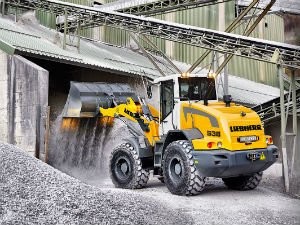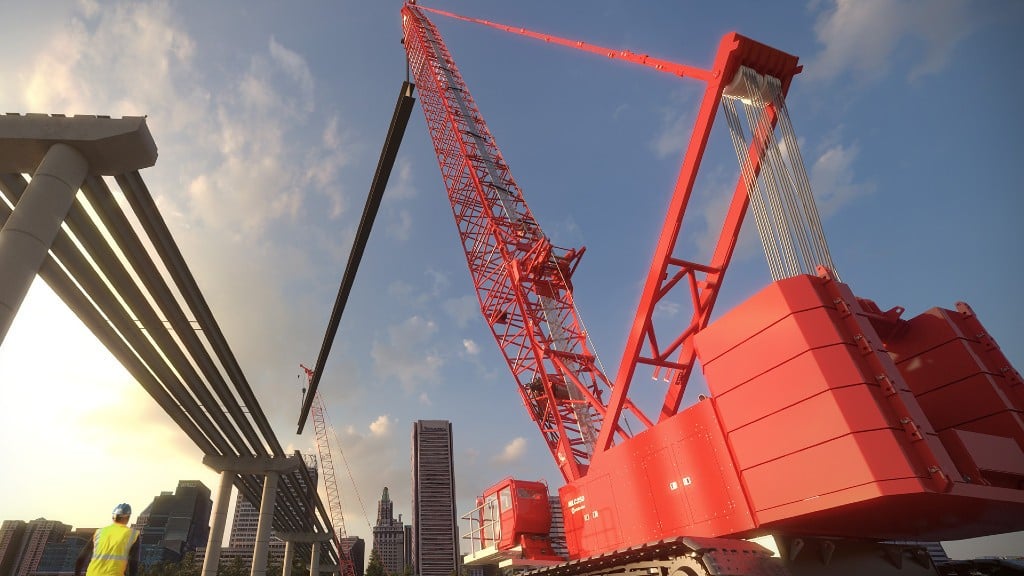
At the 2013 Bauma, Liebherr introduced redesigned midsize range of wheel loaders. The L 524, L 528, L 538 and L 542 conform with IIIB / Tier 4i emission standards.
These “Allrounders” on the wheel loader scene have been further optimised in the efficiency and safety areas in particular. Their performance and stability, their engine output and the power hydraulic ratings are now higher. Throughout their product range, the tipping load limits have been raised and the structural steelwork reinforced to make the machines even stronger.
Many innovations for greater productivity
The LIKUFIX hydraulic quick-change system that has proved so successful on Liebherr hydraulic excavators is now available for midsize Liebherr wheel loaders. Working attachments can be detached and attached in a matter of seconds, working directly from the wheel loader’s cab. The hydraulic lines are connected fully automatically in the same way, with no hydraulic fluid leakage.
As in the past, the purchaser can choose at no extra cost between a Z-bar linkage for standard operations, or a parallel linkage for industrial applications. This way the machine’s specification can be ideally matched to the intended tasks.
For the new midsize wheel loaders, Liebherr has retained its hydrostatic drive concept, and combined it with Liebherr Power Efficiency (LPE) as a means of boosting the machines’ handling capacity and economy. Compared with other wheel loaders in this size category, the innovative driveline concept cuts fuel consumption by as much as 25%. The wheel loader needs less fuel, and tyre and brake wear are reduced.
A Liebherr development, the LPE system influences engine management pro-actively: the machine’s software is supplied with the accelerator-pedal position signal and then computes the most efficient means of implementing the operator’s instructions. LPE optimises interaction of the driveline components.
Liebherr’s design concept for its midsize wheel loader series ensures comparatively high handling capacities, since high tipping loads are possible despite the machines’ low tare weight.
The new generation of diesel engines is now even more environmentally friendly and there have been many other improvements, too: precision common-rail fuel injection optimises the combustion process and reduces pollutant emissions. Exhaust emission control uses a diesel oxidating catalytic converter combined with a diesel particulate filter. In most situations, this filter can be actively regenerated by burning off deposits during operation of the machine, and the work in progress continued without interruption.
Safety, ease of control, straightforward maintenance
These “Allrounders” now have -larger cab windows; the roof has been shortened and the upper part of the windscreen extended farther back. To the left and right of the steering column, the cabin trim has been lowered and replaced by glass. All-round visibility is therefore even better on these new models. A fold-out window for the cab’s door is an option, and makes it possible to open the window completely. The cab is larger and safer, with even higher standards of comfort and convenience.
The new wheel loader generation had excellent ride quality and even more stable, accurately controlled steering response. This is due to the two steering cylinders installed as standard on all these new-generation “Allrounder” models. Design changes to the vehicles’ frames increase stability even when travelling at quite high speeds. More severe surface irregularities are compensated for by the rear swing-axle suspension.
All maintenance points can be easily and safely reached from ground level by opening just one single hood. This is possible because the Allrounders’ diesel engine has been turned through 90°. The transverse location of the radiator, with an air-intake in its customary position directly behind the cab reduces the amount of cleaning work needed, because the air drawn in contains less dust. Cooling system performance has also been uprated to suit the new technological requirements.
Company info
1015 Sutton Drive
Burlington, ON
CA, L7L 5Z8
Website:
liebherr.com/en/can/about-liebherr/liebherr-worldwide/canada/liebherr-in-canada.html



